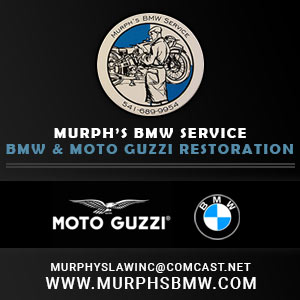DIY Stainless Steel Brake Lines
Anybody out there making their own brake lines out of the hose and fittings available on-line? If so, where have you found 10mm x 1.00 fittings for AN3 ??
Owning an old Airhead is easy.
Keeping an old Airhead running great is the true test.

Long story...
History
Teflon-lined stainless steel brake lines were required to replace the visibly expanding factory hoses on my 1979 R100. Ebay was the first stop and all the low-cost lines are made off-shore. So a "whole bike" 3-hose kit was ordered from Wesmoto (England) for $42. The kit arrived and the rear line fit perfectly, but the fronts were from another model. Wesmoto was easy to deal with, but only during the 45 day return period. Of course delivery took 30 days! Their lines are well-made, but there is no way to tell what you're getting as their ad has only a verbal description. Lesson learned. Other more reputable sources, like Bob's BMW wanted $125 for the remaining 2 front hoses. That was simply over budget. Especially considering that numerous sources offer an 8 piece steel brake line kit for your entire car for less money. Motorcyclist are obviously being overcharged !!
Problem
There are lots of sources for hydraulic hoses made to order, but liability excludes them from being used on brake systems. There are lots of brake hoses offered with standard end fittings, but none of these is offered with metric threaded fittings. Of the few metric fittings available, most are 10mm x 1.25 thread for Jap bikes. BMW motorcycles use the finer thread pattern of 10mm x 1.00, which reduces the number of sources to none in the under-$50 category.
Solution
Then I noticed that brake hoses are available as kits. You buy a AN-3 size hose to your specification and then add the end fittings separately. More work, but very low cost, and a way that offers an infinite number of options. The beauty of it is that you get a USA-made, factory crimped hose you trust, and add the fittings you need. If the hose is too long or the fitting incorrect, you only replace that part, not the entire assembly. Using this method, you could conceivably buy hoses once and move them from bike to bike by simply changing a single component.
How To
First measure the brake line length you need. You'll want AN-3 sized hose with the Teflon (aka PTFE) inner tube. Subtract 1 to 1.5 inches for the added length of the fittings. Decide if you want a coating on the outside, and if so, what color. Generally, coatings are suggested to keep the stainless steel braid from abrading the softer surfaces the line may touch. Hoses are available in any length with straight, 45 deg, 90 deg, or banjo fittings. Click here to see a sample. Only consider the "-3" hoses.
Then you choose your end fittings, again AN-3 to straight (male or female), or banjo. The AN-3 fittings have a beveled end to seal with the AN-3 hose, and share a common thread. For the 1979 R100 (with the master cylinder under the tank) I chose straight male 10mm x 1.0 fittings for the master cylinder, and straight female 10mm x 1.0 (concave) to meet with the steel line on the rear of the fork leg at the stock location. (Attachment to the ATE calipers is somewhat more difficult than Brembo calipers due to port location.) Click here for a selection of 10mm fittings. Only consider the "-3" fittings.
Search for the hoses on Amazon and Ebay to get your best price, then choose a (separate if necessary) source for both fittings. My 2 hoses priced out at under $50 for everything.
Additional resources:
Race Part Solutions (a Fragola distributor)
Summit Racing
Earl's Indy
Russell
Fragola
JEGS Performance Parts
Pegasus
My Parts List
Fragola 342022 22" flex hose, 45deg / Straight ends, black covering
Pegasus 3265-16 Male end, 10mm x 1.00 straight
Pegasus 3265-18 Female end, 10mm x 1.00 straight, internally concave
(I personally suggest staying away from stainless steel fittings as they are weak and prone to break)
Owning an old Airhead is easy.
Keeping an old Airhead running great is the true test.
Check out the brake line article for the R100RT at Gunsmoke.Com. Everything you need is there.
Oh sure, NOW you tell me !! 😆
Thanks.Owning an old Airhead is easy.
Keeping an old Airhead running great is the true test.
Could you elaborate on this please? I feel the same about aluminum brake line fittings, but only because the absence of a fatigue limit for aluminum almost guarantees they will fail after a sufficient time of cyclic loading (vibration). Stainless steel is far stronger and isn't subject to the same fatigue problems. It is more expensive, though, so I just stick with plated steel from a reputable source (i.e. not made in China).
Thanks for pointing that out. You're correct, stainless doesn't break in service. The intended message was that for the average home mechanic, getting stainless fittings into service can be highly frustrating. When the average guy hears "stainless steel" they think "as strong as steel" and "never rusts". That's wrong on both counts. So they tighten the heck out of a $10 fitting and it breaks. Then they have an additional 6 day wait for a replacement fitting. Of course they miss the big ride, so depression sets in.
I got onto this idea while doing a Google search on the stainless steel braided brake lines. It seems like every other link is something like, "%#@*&!!! stainless fitting broke when I tightened it !" People just don't realize it's a very weak material for use on threaded parts.
So the obvious solution is to warn people away from using stainless fittings, and toward plated steel fittings. One company offered nickel-plated steel fittings, and that's an excellent, high strength solution if you need good looking parts. I ended up with zinc plated with gold chromate, an excellent outdoor coating for steel.
So my concern was merely the installation of stainless fittings.
Owning an old Airhead is easy.
Keeping an old Airhead running great is the true test.
- 27 Forums
- 1,859 Topics
- 10.6 K Posts
- 1 Online
- 5,741 Members





